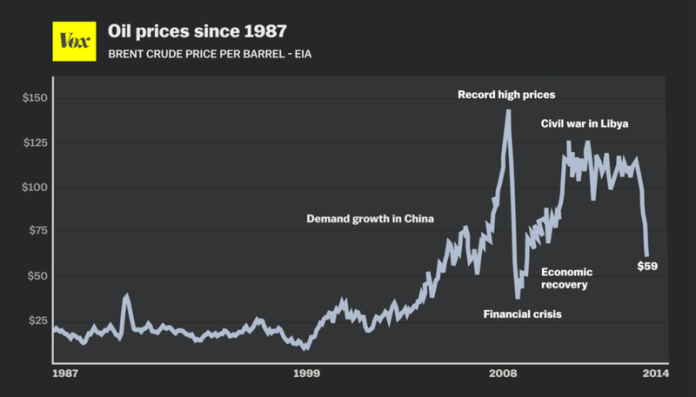The dramatic drop in oil prices seems to have sent shock waves not only in the oil producing countries but also across the globe. No wonder it is the biggest energy story these days. It was only during this summer, when the oil price was $115 a barrel and by mid-December, it had fallen nearly in half to $59 a barrel.
It is not just the actual supply demand that affect the oil prices but also the expectations. The economic activity has a direct bearing on the demand for energy. Like any other commodity, if the producers expect the prices to remain high, they will keep pumping the supply and vice- versa. However unlike other commodities the supply of oil is largely shaped by the decisions of OPEC, which accounts for 40% of the world’s supply.
The backdrop of this plummeting can be traced to four major reasons:
- Low demand: The Demand has been tapering off in Europe and Asia due to weakening economies and partly due the efficiency measures being adopted.
- Easing Turmoil in Iraq and Libya: By mid-2014 these two exporters also saw a gradual easing of disruptions and hence opening up of their key export terminals.
- Shale supplies: The US energy production has also seen a spike due to the extractions from shale formations using hydraulic fracturing in North Dakota and Texas. About 4 million of crude oil was added by US alone to the global market after 2008.
Source: http://www.vox.com/2014/12/16/7401705/oil-prices-falling
- However the foremost factor affecting the prices is the OPEC’s response. The Saudis have decided to keep the production intact in order to retain their market share. This response can possibly be traced back to the 1980s when a similar drop in prices was followed by a cut in the production, which led to a drastic reduction in the market share.
Perhaps OPEC is trying to leverage upon the fact that it’s relatively cheaper to extract oil out of the Gulf countries as compared to the shale formations. This might force the unprofitable producers out of the market and eventually stabilize the prices.
Impact of Fuel Injection
The most obvious and intuitive effect of cheaper oil prices is the benefit to the ultimate consumers. If the downward price trend continues, an average American consumer, say a motorist with an average spending of $3000 in 2013 at the pumps, might possibly be $800 a year better off.1 The importing Asian nations like Japan, India and Turkey are already reaping the benefits. The falling oil prices can drive the inflation down and can subsequently lead to the easing of monetary policy.
However, the consequences of the same are also quite evident. Countries with budgets depending on high prices are already witnessing the shock waves. Russia’s tumbling Rouble, rising interest rates in Nigeria and subsequent devaluation of it currency are some of the evident examples.
How prolonged will these effects be, depend upon how long the prices stay low. The OPEC’s decision, as mentioned above, seems to be a tactic to drive the high cost producers out of the business. Such a shake-out appears to be under way with falling share prices of the firms specializing in shale oil.
However in the long run, the future of the shale doesn’t seem to be that bleak. The process fracking that involves injection of a mixture of sand, chemicals and water in the shale formations to extract oil is a new technology that is quite efficient. Research shows that, with the oilmen learning how to drill the well faster, the extraction cost of a project has dropped from $70 to $57 per barrel.
Clearly, the survivors of this storm have a lot to gain. There exists a similar geology in other places of the world. (Though the same combination of experienced oilmen and keen investors may be hard to find) Additionally, the exploration and development of a shale oil well is much convenient as compared to the conventional oil field. The oil fields that have yet not been explored are at inaccessible spots, deep inside the oceans. America’s Exxon Mobil and Russia’s Rosneft have recently spent two months and nearly $700m in drilling a single well in the Kara Sea. Development of this very field might cost another billions and a number of years too. Contrast to which, a shale- oil well can be drilled at a comparatively minimal cost of $1.5m, in a week’s time. The exploration is also easier, given the convenience of hiring new rigs.
Clearly the economics of oil have undergone a major change. Though 3m that the States pump out is not a very big fraction of the 90m world consumption, it remains to be seen if and to what extent a marginal producer can help reduce the volatility of the oil prices.
References:
